|
|
Welcome to my travel log! You will find here a lot more than in the travel reports, stripped from political correctness. Enjoy! 
Jun 21, 2001 02:00 PM Madagascar - Morombe to Morondava
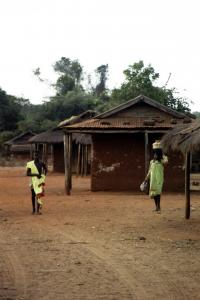 From Morombe, after the eclipse extravaganza beach party, the time has come to set off farther, towards Morondava.
From Morombe, after the eclipse extravaganza beach party, the time has come to set off farther, towards Morondava.
On the way, just before leaving Morombe, I took two hitch-hikers who were quite desperate to get to Morondava. All flights were fully booked by the organised tours (one with the Hilary Bradt) and the 4WDs were either going back to Toliara or those travelling to Morondava did not have any room left in them.
I did not really want to take anyone because the car was not big and it would slow the trip down as additional load would disallow for on-the-edge driving. I knew the road was going to be rougher than the one between Toliara and Morombe. I just wanted to get to Morondava the same night. Well, but because Christopher from Switzerland seemed to be OK, I agreed. The other person was Olivier, a boy from Paris who was travelling through Madagascar from Îles de Kérguélen on southern Indian Ocean where he did his national service. Olivier seemed quite shy in the beginning because he did not speak much English.
The night before, one thing did not get done – filling up the car. In the morning, at 6.30 am the petrol station was still closed. I could not afford to wait until it would open, therefore decision was made to leave anyway with a little bit more of adrenaline in the blood.
This part of the trip became one of the best experiences from the holiday, if not the best.
It was the true feel of the real Madagascar where the white man (vazaha) appearance is a sensation to the locals. There are those small villages full of kids who scream 'vazah'' as loud as they can and wave both of their tiny hands up in the air and run after the car! Their parents also wave and smile very friendly standing by the road (read: dirt track).
In one of the villages, in the middle of nowhere, somewhere in the dry savannah, where my drivers got a bit lost, I stuck my hand out of the car’s window and invited the kids for a hand shake. They did not know what to do, so one of the taller, probably leader of the group and more courageous, ran towards the car, clapped my hand and ran away! He was laughing in happiness so other kids did the same but not all of them were so adventurous. Experiences like that make you want to live and travel, meeting people and seeing how differently people could go through life. And what makes them happy, what brings them joy.
The first 180kms between Morombe and Morondava is very rough and, depending on the driving skills, may take from two days to 10 hours to negotiate. It took us 11 hours with a half an hour lunch stop and another 30 minutes for helping others to get out from a muddy river.
Those people stuck in the river were driving the smaller Mitsubishi and were well stuck, for good. All men from the nearby village (approx. 25 hunters, one shaman and few young boys) stood there watching how the tourists were struggling with the sinking vehicle.
The villagers were not helping at all - they were just observing and commenting in their local language. I thought it was a very special moment of my trip. The guys were very well built, I mean very well built and fit. Most of them were tall and dark. They wore cotton sheets, some of them ‘buttoned’ with safety pins. The hairstyle also varied but most guys had short hair, some of them put a comb at the side or back of the head. That time I shook hands with some of them, they were smiling friendly and while squeezing my palm (all of them knew how to properly shake hands – good friendly solid grip not a dead fish or anything like that) saying something but I could not understand anything so just smiled back.
One of them, who I believe was the shaman, asked me to take off my sun glasses so they could see my eyes.
They were so friendly and I could not fully understand why they would not help the tourists to get out from the river. Later, though, one Malagasy told me that they were just waiting for the travellers to exhaust all the options available to save the vehicle and only then they would help to pull the car. Interesting. It's like watching and waiting until the excess of adrenaline finally kills you... Well, since there's no television they have to have some other sort of entertainment - it's understandable and I'm happy for them.
Most of the day we spent on driving through savannah, on a dry land – sometimes through a small river or on a rocky track. The driving was based simply on guessing the way. This was because of the map I had. It was not detailed enough. No surprise – that was the most detailed map available in the UK or via the Internet however those detailed, really good, Malagasy maps were out of print.
The local people therefore were the map and many times they said – no, this isn’t [name of any known village that should be on the route], it is [another village that actually was on the route]. It was a blessing to have Houssen with us, who could talk to the people. The discussions sometimes took quite long because the locals were interested in the conversation and, better else, in the vazahas in the car.
When the road became an enormous beach – several kilometres (less than several miles) long and very wide, at least one kilometre wide (about one thousand yards wide), the petrol tank was drinking the very last drops of the diesel. Being on a massive beach automatically means that this is rather not a place where petrol can be found. However it means that instead the level of the adrenaline in one’s bloodstream, which I mentioned before, increases considerably.
After stopping at the first village it became apparent that even in the touristy place like Belo-sur-Mer some 50 kms (31.1 miles) away in the opposite direction, there was no filling station. Furthermore, there was no-one in the village who would sell some diesel, because the villagers were not using machinery that would be motorised or run on petrol. It was getting interesting, or better, exiting.
Well, after the spare containers were emptied and the all the diesel we had was in the tank, we realised that the car would go just slightly farther than 100kms (62.1 miles) and we had approximately 100 kms to go to the first petrol station which was located in… Morondava. That was one third of the way that remained before us and the sun already set five minutes ago. Tough. Decision had to be made and I decided to go as far as we can because even if we had to walk the last distance it should not be too long … right?
After it got completely dark, driving got more challenging. This was due to a few factors like: sand track in the tall and thick bush, wild animals, and rivers to cross. One of the rivers was 400 meters (437.5 yards) wide, there was no bridge and it was completely dark! There was no bridge and no ferry. Nothing on what to cross the river, however at both banks of the river people lived – literally on the river’s banks. The local people lived there to live on what they could get from people wanting to cross the river.
As there was no turning back for us and we had absolutely no willingness to linger by the river until the sun wakes up, it did not take long to debate whether we were going to take the risk. I am happy we did that as this one was again an exhilarating experience! The locals simply stood in the river with burning torches marking the places where the river’s bottom was flat and the water was not deep.
Already in the river, we all had second thoughts why we actually agreed to do that. Soon we realised that it was very risky as the river was not very lazy. Well, we didn’t see it before and we had no clue how deep it was. As we approached to each of the burning torches, the person submerged to the chest shouted something in Malagasy and only then was it visible how deep the water was and how fast it was flowing. I am sure that everyone reading this would agree with me that driving through the river in complete darkness only with headlight on but deep in the water was pretty thrilling, particularly when this was the river-through-in-the-dark driving first time in my life. I cannot even remember exactly whether water broke into inside the car.
One crossing cost around MGF 2,000 (£0.20) so it was reasonable good money for them, given the fact that at one of side of the river there was Morondava and at the other, Belosur-Mer – the diving and snorkelling centre, a bit commercialised and not very nice yet a destination on many people’s itineraries. Those two places guaranteed certain level of traffic and four to five vehicles should pass the river everyday.
At the other side of the river, a pleasant surprise was waiting for us. The track of the last 100kms was in decent condition allowing for driving even at 70km/h (43.5 mph) so my plan to reach Morondava in a day appeared not only reasonable but also feasible and at that time … done! Just! The very last minutes of the trip were again electrifying because I have never driven through a jungle at night before, plus the speed and no signs – just driving based on instinct. Yeah!
|
Jun 20, 2001 02:00 PM Madagascar - Morombe
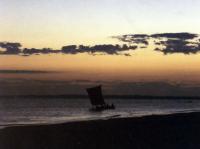 This seaside village-town was my main destination of the trip to Madagascar. It was the prime destination for all the eclipse chasers including people from NASA, professors of astronomy or solar science from many British universities. And the excited back packers who either heard about the extraordinary thrill of this phenomenon or have experienced that before and now cannot stop chasing the next ones. Morombe was in the very centre of my itinerary and all other things and places to visit were planned carefully around that town and date – Morombe 21 June 2001.
This seaside village-town was my main destination of the trip to Madagascar. It was the prime destination for all the eclipse chasers including people from NASA, professors of astronomy or solar science from many British universities. And the excited back packers who either heard about the extraordinary thrill of this phenomenon or have experienced that before and now cannot stop chasing the next ones. Morombe was in the very centre of my itinerary and all other things and places to visit were planned carefully around that town and date – Morombe 21 June 2001.
Morombe is rather small, very pleasant village-town whose name means ‘vast beach’ and that is entirely accurate. The beach was huge and beautiful. This settlement is actually placed on the beach. The sand extends for several hundreds of meters (almost the same distance in yards) into the village, so the ‘streets’ between the houses are made of beach sand.
Only some official buildings like banks, administration, police station, post office and such as well as most of the private hotels coming from late seventies (I do not know when they were built but the architecture resembled the late seventies buildings in France) and some shops are located on the main gravel street, behind few rows of houses from the beach.
The main residential area, where majority of the fishermen, naturally, live is located at the shore.
The small restaurant in the centre serving excellent and cheap seafood was the place where we met again the other Range Rover crew. La vieille had another problem and this time it was me who was invited to do the… interpreting. This was a shock to me as well. I have only been speaking French few hours and they already take me for a half professional translation. Flattered and challenged.
The problem was that she was admitted to a tent on the beach where she was supposed to spend the night. Then when, she peacefully started to unpack her sophisticated photographic equipment, computerised and synchronised in the purpose to make the perfect picture of the eclipse, two individuals enter the tent claiming that the tent was theirs and she had to leave. So she left and complained to the personnel but they insisted that she should stay in the tent and they would sort these other people out. But since that was in French she did not fully understand and sought assistance from her driving crew. They, however, could not understand what she was saying and, even though they knew what the problem was, they could not tell ‘la vieille’ what the solution was.
My interpretation was simple, clear, direct, faithful and contained all the dialogues from the French films I could remember at the time. Well, since my favourite French films are mainly comedies with Louis de Funés and Bourvil, the entire situation all over sudden appeared for the French and Malagasy guys to be amusing to tears as I could not stop myself making faces as well.
I amused myself as well but I have to admit that the la vieille was shaky all over, was not amused at all. I think it was actually better that she did not have a clue about the choice of my words used to explain the situation.
Fortunately, my interpretation was lucid and comprehensive and the lady was finally a lot happier. This all solved the problem and we could continue waiting for our food, which took ages to arrive.
The restaurant, whose name I cannot remember now, although served magnificent food at extremely reasonable prices – the grilled tasty lobster tails (more than eight small tails) cost just MGF 20,000 (£2) – the service could have been a lot better.
The two Malagasy people with whom we were dining were outraged by the level of service. It was not considered unreasonable by the owners and waiters to believe that the hungry (otherwise why would they be there?) guests will wait two hours to be served the first dish. Having had that experience, we decided to order our next dinner 24 hours in advance.
The next day, when people saw us being served within minutes, they were truly shocked! So were we, since we did not really believe that they would have everything ready for us.
The rest of the night, the night before the eclipse, I spent in the nightclub ‘Eclipse’ (surprise, surprise) listening to the local disco music and watching how great fun the people could be having! A lot of them, however, were drinking much of the locally produced rum that could be even 70% strong. It was sold in small plastic bottles.
The club was however, a very good place; music was decent (only Malagasy tunes), great hot atmosphere, plenty of local people and vazaha backpackers and there was enough room to boogie or just be sitting, drinking and watching others going slightly mad.
When we (myself and my drivers) left the club Vincent noticed that his bag was missing from the car! I was not excessively surprised as the car could not be properly locked and it was relatively easy to break in through the back, which was being closed with a soft plastic top ‘locked’ to the car with non-secure metal clippers. I was so glad I did not leave anything in the car that night!
The bag contained the vehicle papers, his passport, driving licence, insurance, etc. It all then threw a dark shadow on the progress of my trip. We did not know what the police would say and since there are many inspections on the roads and the Malagasy police, gendarmerie and militaire are not the easiest people to deal with, it was questionable if we would be allowed to continue driving. They are also not the fastest people on the planet – like almost everything else on Madagascar, where everything is ‘mora mora’.
The Police Department (or should I really say “police one room office”) was in Morombe open 24x7, possibly due to the eclipse chasers that year. They were very friendly and helpful, despite the fact that the help had to take more than 20 hours! This is how much it took the chief of the office (only him would deal with this case as Vincent was an immigrant from France and white) to type two-page document on an old fashion typing machine.
The typing machine had to be in use to produce the report and an explanation paper that Vincent had to keep with him at all times. This was necessary so I could continue travelling with the car without my driver’s driving licence, and his passport. This was a very important issue because police/gendarmerie/militaire checks are quite frequent on Madagascar’s roads.
|
Jun 20, 2001 02:00 PM Madagascar - the Total Eclipse of the Sun (Morombe)
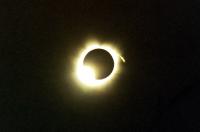 The day of eclipse was easy. I spent half a day on the beach trying to catch some sun because that was the very first time I had an opportunity to get some tan. My itinerary so far did not allow for laziness – it was tight and involved a lot of hiking in the jungle and visiting national parks. The Nosy Boraha weather did not necessarily please me. The beach was not planned however that day, but because Vincent had to deal with the police to sort out the missing papers, the car was not for use on any large distances.
The day of eclipse was easy. I spent half a day on the beach trying to catch some sun because that was the very first time I had an opportunity to get some tan. My itinerary so far did not allow for laziness – it was tight and involved a lot of hiking in the jungle and visiting national parks. The Nosy Boraha weather did not necessarily please me. The beach was not planned however that day, but because Vincent had to deal with the police to sort out the missing papers, the car was not for use on any large distances.
It did not matter at all since the beach was vast and clean. It was not crowded at all. The only people on the beach were those who arrived to Morombe to see the solar eclipse, astronomers, astrophysicists, solar science specialists and experts, astrologists, professors from the UK and the US universities, their assistants and the assistants’ assistants, solar eclipse maniacs, maniacal photographers (soon they will include me, I think) and me.
The time of the first contact approached very quickly and the first bits of sun became obscured by the moon. People who have never seen a solar eclipse before, not even the partial one, were surprised that the reduced sun was still producing so much light that it was not possible to notice any difference from normal, everyday situation. I gathered with my drivers and some other people (including the second Range Rover team) at the beach away from my commercialised and well overpriced hotel.
All of us were waiting along with many locals some of whom I remembered from the night club from night before, long legged running chickens, and music from nearby bar that closed for the time of the phenomenon.
Many of the locals had the special spectacles to safely view the partial eclipse, but there were some who had none. Fortunately, I had bought 10 such tools in the pharmacy in Antananarivo, so I could make some of the eager spectators happy giving away my spare ones.
Together with everyone I was watching the Sun disappearing behind the Moon. We were trying to estimate what percentage of the coverage of the Sun it was at given time. We would then try to imagine how the sky would be looking like in other parts of Madagascar – like Toliara, for example, from where Vincent, Houssen and others came.
I set my camera according to instructions I found in books, photo magazines, Internet and according to my experience and intuition. I also remembered not to look though the camera all the time or trying to operate it. So I stood back, talked to others and contemplated this unusual event.
When the moment came and the Moon covered the Sun fully, it was a shock to everyone to experience how quickly it got completely dark. The temperature dropped by 16 degrees in Celsius scale (28.8 degrees in Fahrenheit scale) and everyone could feel the difference! It was awesome!
Some of the locals ran away hiding in their homes despite our assurances that it would be a great view and fantastic experience, and for them – the one only once in a lifetime. They did not listen, and went away. Some of them however stayed watching and wowing and being happy.
Chickens, which were running (literally) across the beach suddenly stopped completely and covered their heads under their wings trying to fall asleep. It was very funny to see them standing still with their heads hidden – looking like they were beheaded or something. Other birds also went quiet. There were no sounds but people’s comments and wowing. Even the music from the nearby bar stopped playing. Everyone was concentrating on what they were seeing. It was truly intense.
This is what was seen: The Sun was covered completely at some 12% above the horizon. Because it was at the coast, about half of the horizon could be seen from the shore and this added even more excitement to the view. In few words, for just over two minutes we had 360 degree sunset twilight, deep red, burgundy colour of the sky like it often appears half an hour, forty five minutes after sunset. This was already astonishing! The area closer to the Sun was completely black, like at a moonless night – the shape of the area was a triangle, gigantic triangle with one angle touching the ocean and two others high above the Sun. I simply could not believe my eyes!
The sky was clear like crystal, without a cloud so the visibility was perfect. At the first moment, the Baily’s Beads appeared from the right side of the Sun and were created by the light travelling through the valleys and craters on the Moon before the moment when the satellite covers our star completely. Then, immediately after that, the Diamond Ring appeared from the right side of the Sun. It remained there only for a second or two but it was long enough to appreciate. Then the Sun was totally eclipsed.
The Solar corona was large and clearly visible, some of the massive solar explosions could also be seen through binoculars or through a camera zoom lens.
If that was not spectacular enough there were Jupiter, Saturn and Mars clearly visible (Jupiter the most) next to the eclipsed Sun and some of the remote stars of our galaxy managed to expose their light to everyone’s eyes.
Then, two seconds before the sunlight came back and the daylight returned, the Diamond Ring and the Baily’s Beads reappeared, on the left side of the Sun this time, telling that the show of the totality was over. Many however stayed watching the remaining parts of the spectacle – the third and fourth contact and the exquisite sunset of the crescent sun.
‘Unforgettable experience!’ does not even begin to tell what it was like. It was very powerful and although it felt like an hour of a show, it was only a short while, but these two minutes and eleven seconds made me want to see that again, and again, and again. I decided that from then on, I would try to synchronise my holiday plans in forthcoming years with the solar eclipses.
Next one is on 14 December 2001 in Central America, the place I have not yet visited. Then, on 4 December 2002 in southern Africa, covering areas of Angola, Namibia, Zimbabwe, South Africa and Mozambique – places good enough to choose for a holiday, anyway. Sufficiently exotic.
I went to the NASA website on the Internet to see what they had to say about solar eclipses. I found something fantastic – maps and tables of all full solar eclipses on our planet for the next thirty years; total, annular and hybrid. The information there is more than sufficient to judge what sort of eclipse there will be. How long, in which country with what magnitude, etc. How about holiday planning like this?
|
Jun 19, 2001 02:00 PM Madagascar - Toliara (Tulear) to Morombe
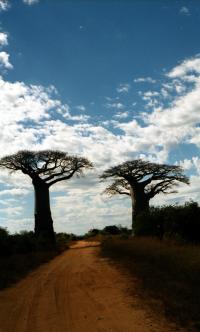 The route from Toliara to Morombe was my very first time off the beaten track. Still far, far, very, very far from being the traditional ‘off beaten track’ according to the Malagasy standards as it is actually one of the most popular dirt roads on Madagascar. Its ‘beaten offness’ was rather of a European standard because the road was rather of the average quality, according to the Malagasy standards. Still an exiting driving, I have to admit.
The route from Toliara to Morombe was my very first time off the beaten track. Still far, far, very, very far from being the traditional ‘off beaten track’ according to the Malagasy standards as it is actually one of the most popular dirt roads on Madagascar. Its ‘beaten offness’ was rather of a European standard because the road was rather of the average quality, according to the Malagasy standards. Still an exiting driving, I have to admit.
Just outside Toliara, traces of the civilisation disappeared along with… the road. Driving became an activity not only requiring proper equipment but also skills. The road resembled never-ending sand dunes. Negotiating the tracks left by other, a lot larger vehicles was exiting enough for me to forget about my camera, which, with every single second, was acquiring at least the same amount of dust as my blood was gaining adrenaline.
Sometimes however, insufficient number of bridges would only make one strongly believe that the rivers must be shallow enough to allow for crossing them. That is strong believer, I mean. Since there is fortunately some sort of public transport between Morombe and Toliara, it stimulates the belief but this nevertheless remains the Camel Trophy like ride. And I am not joking here at all. One big Mercedes truck did not make it... and got stuck in one of the rivers. If I may mention it again – this also stimulated my imagination.
Soon, after I have passed the second village I knew that this would be the best experience of my holiday! And it certainly was. Until that moment, of course, because things were only getting better.
Now, when I think about it I cannot believe that people were so warm welcoming, hospitable, friendly and genuine! Children screaming and waving made it all happen even better. I was so unhappy that my hands were not long enough to wave back to them from the windows at both sides of the car. I tried hard however not to disappoint any child there on the road waiving and hoping for a wave back from a ‘vazaha’.
The kids were screaming ‘vazaha’ which pronounced as [vaz’a:h] sounded extremely similar to the ‘whassup’ from the Budweiser commercial, one version of which is actually played by animated chameleons, by the way.
In the car, we were playing the edited version of the MC Hammer’s ‘Can’t Touch This’ where instead of the title line, the DJ input ‘wassap’ as from the Budweiser’s advertisement. You cannot even imagine how well it played together with the real screaming kids and how it did rock up the atmosphere!
Furthermore, it lasted all day – soon after sunrise until immediately before sunset.
When I travelled there at an incredible speed in this yellow Land Rover on this truly bad, bad track I thought that my dream came true! Travel like that makes one want to live the longest possible and visit all these beautiful places, meeting all these incredibly friendly people and tell them about the rest of the world and take pictures of them and then send the pictures back to them to make them happy.
Another addition to the greatness of the day were the massive baobabs on the way! Much more photogenic than those around town of Morondava, where the most photographed spot on Madagascar is located.
On this track was the first time when I got so close to these magnificent trees. I could not resist and had to stop and touch them, although I was quite in a hurry to make sure I reach Morombe not long after sunset.
Then, naturally, I could not stop myself doing two things:
taking as many photographs of the baobabs and surroundings as possible without realising how expensive it would eventually get to develop all of them back in London; and
pissing on a baobab watching how strangely urine flows on the very smooth skin of the tree, I even think that the little cute yellow river on the tree was turning left, like most of the things on the southern hemisphere.
Vincent, who was driving the car proved his excellent skills. I think we were travelling on an incredible speed like it was a race or something but I did enjoyed it a lot and it all meant that we would get to Morombe well before the nightfall, which should increase the chances of finding accommodation on that busy night, last night before the BIG EVENT.
On our way we only stopped twice: first for hard chicken lunch at the Hotel California, some two fifths of the way; and second an hour before the destination pooling out another Range Rover, whom we actually met at the Hotel California.
At the Hotel, where we met these people (Vincent and Houssen must have known them), there was some confusion around a British female at a wise age. She had a problem in understanding French (she actually did not understand anything at all) and her drivers did not speak enough English. I would like to say a major communication barrier, which is not much of a problem in Madagascar unless there are other problems to solve.
The problem was about the contract, which she signed without proper understanding that they drivers would not provide food and accommodation but the transport. Vincent therefore was asked to help in translating and I called her ‘la vieille’ like from the brilliant French comedy with Louis de Funés ‘La Folie des Grandeurs’. La vieille means ‘an old female one’ or in other words ‘witch’. Well, she looked a bit like a witch.
It was her in the car that needed pulling from the side of the track. It was funny that she was destined to few problems on her way to the eclipse. Not only must have she been shaken up after founding out that she had to pay for her food all over sudden, but now when lying in the deep road side canal, she had her luggage in her hand speculating whether she should really consider walking the remaining kilometres (a bit less than remaining miles) to Morombe. She already must have thought that that was the holiday from hell.
I arrived in Morombe just before sunset, which was already spectacular and I was all covered, literally, with red sand-dust. I had sand all over me in fact. I also had sand in certain parts of my body! So certain parts that I am still not entire sure whether I fully understand how this could at all have happened.
|
Jun 18, 2001 02:00 PM Madagascar - Toliara (Tulear); day two - cash and car
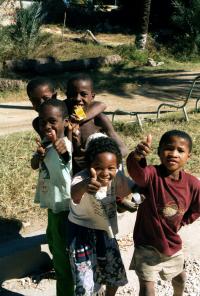 I visited the bank, first time outside the capital city of Antananarivo. I wanted to take some cash advance on my credit card.
I visited the bank, first time outside the capital city of Antananarivo. I wanted to take some cash advance on my credit card.
I could not comprehend the system at all. I quickly realised though that it is a weird way of queuing but I still do not understand that. It is something to do with putting papers (in my situation passport and credit card) on the long, long counter in a way of queue. Then, it does not matter when one is standing, or sitting for that matter, as the papers are queuing themselves on some sort virtual conveyor belt. And this can last hours! Amazing, is it not?
It eventually turned out that I had to leave my card with the clerk and wait for an hour. I went for a walk then.
Outside Antananarivo, all banks have got the same system: you leave your card after having said how much you want and then wait from 30 minutes to 5 hours, depending on the bank, condition of telephone lines or the remoteness of the place. This is such a normal procedure for the Malagasy, that there is absolutely no consternation or grimacing on any one’s face. I quickly got used to that.
Then, after I had all my money, the time has come to collect my 4WD. Then, of course I did not realise it immediately, was also the time that the level of the adrenaline in my blood reached a very dangerous level. A top level, really!
Mr Didie, with whom, I had thought, I reserved the vehicle, screwed me. He sold the car despite my reservation. It was the very first time also when I was, so called, challenged to use my French. Well, before I knew one thing that people who are three sheets to the wind cope with any cultural and linguistics differences very well, but I realised then that it may sometimes apply to angry people.
When I was there throwing thunders, meat and some other remotely recognisable as Krys-like wording (in many different languages, I might have thrown a hybrid now and then, but I cannot remember well), behaving like at least an endemic animal, the solar eclipse was not going to change its timing at all.
After my lengthy monologue and a lecture on civilised business making, Didie promised to find another car for me so I waited an hour. Nothing happened and I just got more pissed off, one can easily imagine. I know that I was mad and knew it then, but I do not how it suddenly occurred to me that I was on holiday. Furthermore I realised that it actually was my holiday, so I got even more cross and thought how good it felt. I have not been so angry for a long time. On a hindsight, I guess I was just about to lose my senses…
This is what happens to people working in the services sector where one needs to be polite all the time. Although it felt good to be pissed off, I was still unsure how I would be making my way to Morombe.
I called the lady in Antananarivo telling her well off and complaining about the entire situation blaming her for everything, right or wrong. She promised to solve the problem but naturally I started to look around myself.
Within reasonably (in Malagasy standards) shortly, I had three unconfirmed options and needed to wait as everything in Madagascar is happening 'mora mora' (slowly slowly).
Also, I met a guy from South Africa who was gathering people to fill in a massive military truck to go in my direction but only half way - to Morombe. It was cheap and funny so I agreed to take it. Then, I decided to wind down a bit and sat at a table in the city centre trying some local beer and tonic water. It was in the city square, in one of the ‘pubs’ lined up along one of the square’s sides. I sat in the open air on a white plastic chair and watched people passing by. I actually spotted one of the Didie’s people showing off on one of their quad-bikes.
In the meantime, a driver approached me lying that he can take me to Morombe, Morondava and even Antananarivo. But he wanted to screw me as well. He already had been paid for the entire trip and I would have to share the car with his two other clients (who paid everything already!).
Not only did he want me to pay him like I was taking the car only for myself or something, but wanted twice as much for fuel (that he again had been already paid for). Unbelievable! I calculated everything while he was sitting at the table and proved him how pathetic he was changing his mind about the price all the time trying a new lie on me, believing that I was completely stupid!
After ten minutes in this grotesque conversation, I made my day. I made suggestive faces and called him, very politely, what kind of a disgusting person he was and then he left. I was very content, and reported everything to the girl at the Maison du Turisme in Antananarivo, of whom he was an acquaintance.
New options fortunately started to crystallise and I finally found a small Land Rover. Amazingly, I concluded the agreement with two, good old-fashioned handshakes! That was extraordinary.
The guys, however, looked kind of suspicious at the first sight, but my perception might have been affected by the earlier experiences that day. I did not sleep well that night though, not being sure whether next morning, at seven o’clock, the car would be there.
The lady at Chez Alain, a decent hotel close to the main taxi brousse station, who arranged for the rental, looked very professional and I should not have had any reservations about the car. Well, it finally occurred to be the best deal, in fact.
By the way, it was amazing to see how prices started to double, triple and quadruple from hour to hour, just as the eclipse was approaching. There were instances that the prices rose to £250 (two hundred and fifty British pounds) a day plus petrol. That’s theoretically per vehicle, but practically everyone from the rental companies all over sudden started expecting every single passenger to pay this amount. Some kind of entrepreneurship! I therefore considered myself a lucky person, after all. For a moment I was however not forgetting that that was definitely not the end of my problems to solve that day.
Another problem was the hotel. There were no rooms available in any of the hotels in the town!! Everything in Toliara was booked because of the bloody president's visit. I actually did not care to find out why he was visiting the town. I could see that the army was rehearsing in the dusty streets for the entire morning and causing an incredible communication chaos in the downtown.
The president of Madagascar, Ratsiraka, is like a king and he has been in the post for more than 20 years. He lives in an enormous palace outside Tana and has a lot of power. People actually call the system not a democracy but democratism!
The same lady from Chez Alain, Elianne, who helped me with the car, promised to find accommodation for me for Tuesday night. What a very nice and helpful person!
Hotels, once reported in the guidebooks as cheap, have become a top range priced. It was not however the problem as they were fully booked anyway. I was nevertheless a bit concerned whether Elianne would be able to find anything for me at all. Her colleague at Chez Alain laughed when Elianne was ensuring me that there are hotels in Toliara that are not fully booked and she’d find a room. Her colleague at Chez Alain joked that if not, Elianne would take me to her house.
Well, Elianne and I made an appointment in the evening at my current hotel so Elianne would advise me where I would be staying the next night. She came and said that she did not find anything for me at hotels and that I would come to stay at her home. She would pick me up at 10 o’clock in the morning.
I was thrilled, ha! Who wouldn’t be? But after I came back from the restaurant just across the street, I found that Elianne left a message for me, which said that there was a hotel with empty rooms and that she would come in the morning to collect me and take me there. I was happy and remembered that day I already thought that I was lucky. The restaurant across the street was really good as well, and I could not resist from having garlic giant prawns. And fish soup!
At sunset, a bit before the time I found my next night arrangements, I had bought some woodwork, or better woodcarvings, (masks, zebu, people) to make my day. That was an interesting, long, and a good day so it was important to make sure it was ended properly. I decided to play a bit with the ‘artists’ there and started twisted conversations. Remember that I did not speak French, or Malagasy for that matter, and had to improvise most of the time.
I decided to get some gifts to my friends back in Europe and browsed through the local art. They had many different items over there, including seashells, starfish, bracelets, wooden animals. I liked the tall, super slim woodcarvings of people. I was joking with the locals that the sculptures were representing vazahas, because the did not carry many of the very African or black people features. There was a lot of discussion about it and a lot of laughter. I simply refused to believe that these were actually Malgasy people, and the artists would try harder and harder to convince me that they were actually Antananarivien people from the capital. In fact, the people in the east do look a lot less than black people and those who live in the south and west of Madagascar.
It was a good trading activity and all of us shook hands at the end of the deal. I bought a few very tall and super slim carvings of people from the Malagasy capital. And a few masks as well. I was not sure whether that was such a good idea, as I was just at the beginning of my holiday, which meant that would have to carry these items until my last day on this island. Somewhat cumbersome, but I felt good – shame about my rucksack.
|
Jun 17, 2001 02:00 PM Madagascar - Toliara (Tulear); day one
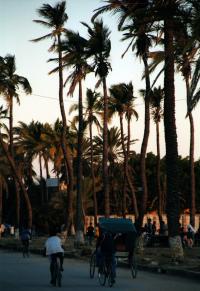 Toliara is one of the nicest places, or towns in Madagascar. It is similar maybe to Toamasina on the eastern coast, but with wider avenues and palm trees. And with better food and larger pousse-pousse (for taller and darker people)!
Toliara is one of the nicest places, or towns in Madagascar. It is similar maybe to Toamasina on the eastern coast, but with wider avenues and palm trees. And with better food and larger pousse-pousse (for taller and darker people)!
The most important aspect of Toliara’s advantage over Toamasina is a lot nicer weather. The disadvantage however is – no beach. Instead, there is mud, mangroves and shit, yes shit. When I read in the guide book that one of the travellers reported that one of the most comfortable hotels in town promised the room with 'vue de la mer' they instead received one with 'vue de la merde'.
I was thinking about it on my way to Toliara, but was not sure how to imagine it. Unfortunately, now I have seen it and smelt it myself!
The city centre is pleasant and somewhat civilised but the uptown looks like a village with small bamboo-palm huts, the whole range of animals and agricultural fields. It was not surprising for me anymore at this point, as I have seen similar combinations at the earlier stages of my trip, including Tana. It was actually interesting to see such a consistency.
|
Jun 16, 2001 02:00 PM Madagascar - Ranohira to Toliara (Tulear)
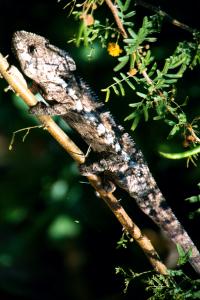 First enormous and extremely photogenic baobabs appear almost exactly on the road, some 150 kms (90 miles) before Toliara. They are the first three species of this amazing tree I saw and they were every here and there, between the houses, in groups or completely alone. All of them endemic (unique to Madagascar), some examples were truly magnificent!
First enormous and extremely photogenic baobabs appear almost exactly on the road, some 150 kms (90 miles) before Toliara. They are the first three species of this amazing tree I saw and they were every here and there, between the houses, in groups or completely alone. All of them endemic (unique to Madagascar), some examples were truly magnificent!
The evidence that the villages really get poorer is simply striking. Houses are no longer made of bricks but small huts of bamboo and palm trees. These are really small ones that five regular office desks would hardly fit in them. No windows – just one entrance with door made of colourful fabric, probably cotton that grows conveniently just in the back yard.
People appear with more African faces, and are darker, wearing less clothes – some wear only colourful cotton robes; both men and women, men sometimes wear just shorts or slips, small children – nothing. All of them are smiling very friendly. Kids keep shouting 'vazaha!', smiling and waving with both of their slim hands. Adults keep greeting raising their hands, smiling and some even bowing. It is an incredible and fantastic feeling, difficult to describe and not so straightforward to understand how all the Malagasy could be so friendly and with so much respect towards white people whom they know and see so few.
|
Jun 15, 2001 02:00 PM Madagascar - Isalo National Park; day two & Ilakaka
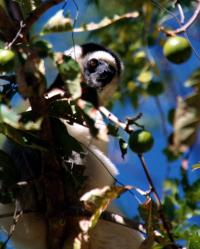 On the second half of the first day, I went to see L’Oasis, which was kind of recommended by one of the guide books I was dragging along with me across the entire country. This proved to be just a campsite and terribly polluted as well. It is albeit quite an attractive place. The oasis looks very nice but I would not dare swimming in the pool. At least couple of lemur species were supposed to be there but I could not actually see any.
On the second half of the first day, I went to see L’Oasis, which was kind of recommended by one of the guide books I was dragging along with me across the entire country. This proved to be just a campsite and terribly polluted as well. It is albeit quite an attractive place. The oasis looks very nice but I would not dare swimming in the pool. At least couple of lemur species were supposed to be there but I could not actually see any.
At the top of the L’Oasis, a few men were collecting water from the stream and filling a larger container placed on a very old, on its last legs, van. They were singing and making silly comments. It was so funny and surreal like the Big Brother, reality television show. When they saw me they kind of stopped for a short moment, said ‘hello’, smiled and after a while continued singing funny songs and making even sillier comments.
Few moments later, two other guys approached me demanding MGF 10,000 payment from me claiming it was a private park, which was not true. I tried not to look very pissed off and replied that they cannot charge me just for having a look. I knew it was possible to camp there but even the official camping sites charge MGF 5,000 - 7,500 for one tent per night – how much they charge for having a look I don't know. Things like that put me off enormously. So much that I could even be forced to change my mind about Malagasy people completely. These guys, who were packing the stream water to this large tank, were not charged for being there, nevermind the water!
Fenetre de L’Isalo, a hole in a rock – another attraction of the park, is heavily advertised almost everywhere and this actual place is even signposted, like very few things on Madagascar. When I got there, I found that it is actually nothing special, as I have seen a lot better and nicer holes in the rocks in my life before.
I went to see this hole at sunset. Unfortunately, the sun was not setting yet and it was a bit too sharp for viewing and taking pictures. The sun does not really set in the window but disappears behind the distant park’s Jurassic massif, so there is hardly a chance for a good photograph anyway. The surrounding area however strikes with vastness and tranquillity, screaming silence!! As I was waiting for the sun to go down, I actually lied down for good half an hour on the ground under the Fenetre and thought of life, the universe and everything…
About 10 kms (6.2 miles) from the Fenetre de L’Isalo there is Ilakaka, a real Wild West of Madagascar! It is a place where sapphire mines have recently been opened. So nowadays, there are guys from Sri Lanka and Thailand walking around with big guns wearing American cowboy style hats and mirrored sunglasses, pretending that they rule. They are reportedly claimed to do so actually.
Every second hut in this artificial village has a ‘Something Saphir’ or a ‘Saphir Something’ name, like ‘Max Saphir’, ‘Johnny Saphir’, ‘Saphir Blue’, ‘Saphir Mario’, etc. Weird place. Plenty of bandit stories around as well and people driving BMWs.
Farther southwest from Ilakaka, the road is getting increasingly worse with every kilometre (0.67 mile) but remains in a 2WD condition. The scenery for a while remains dramatic with the Jurassic massif in the background but everything else becomes drier and drier. The villages get poorer and poorer. People, taller and darker, better built with even more fantastic smile, still extremely attractive, very pretty. And again a lot of utterly cute children everywhere.
|
Jun 14, 2001 02:00 PM Madagascar - Isalo National Park; day one
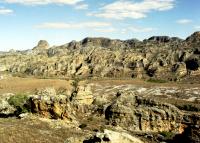 This place should really be called 'National Isalo Jurassic Park' since the massive is from the Jurassic era. The entry fee is like to all other national parks: 50,000 MGF but the guides are extremely expensive. It is not difficult to imagine that when paying 125,000 MGF per day, the guide must be very well off since an average Malagasy person makes 70,000 MGF a month! It is like paying in England a national park entry fee amounting to GBP 1,700, plus GBP 2,800 cash in hand for the guide... How would this stimulate tourism in the United Kingdom?
This place should really be called 'National Isalo Jurassic Park' since the massive is from the Jurassic era. The entry fee is like to all other national parks: 50,000 MGF but the guides are extremely expensive. It is not difficult to imagine that when paying 125,000 MGF per day, the guide must be very well off since an average Malagasy person makes 70,000 MGF a month! It is like paying in England a national park entry fee amounting to GBP 1,700, plus GBP 2,800 cash in hand for the guide... How would this stimulate tourism in the United Kingdom?
The park itself is very impressive – some say that it is some sort of Malagasy Colorado. The scenery nicely resembles the photography from 'Bonanza', the American TV series. It's been a pleasant recollection from the trip to the USA. It does not however resemble Colorado almost at all but rather Utah. All those Americans who say it is the Malagasy Colorado must have never been to Utah, where the Zion National Park, Natural Bridges and the Canyonland are amongst the best places I have visited.
Well, already in the States I realised that the
Americans do not travel at all. They do not know their own country and cannot appreciate the natural beauty of their motherland!
The Isalo National Park is massive and to properly explore the land, one would need more than a week. At the other hand, however, it can get boring after couple of days, as the area does not change its look too much.
The problem is however that the guides available and obligatory for the park are very lazy and they do not want to walk too much. They just want to do half a day and earn the full day fare. They will even try to lie saying that the route you want is not possible because it is too far, too far or too far. They do not realise that there was never too far for me. I can walk all day, and I do not want to make too many stops for the breath catching on the way either. If the distance was exceeding the range of 10kms (6.2 miles) they claimed that they could not do it, because… or because… or because.
The majority of the guides claimed that to do Piscine Naturelle, Canyon des Makis, Canyon des Rats and maybe Canyon Namaza which in kilometres is: 6+9+12=27 (in miles: 3.7+5.6+7.5=16.8) cannot be done when you arrive at 9am. What!? One cannot do 27kms (16.8 miles) between 9 and 5?!! This is 8 hours! In 8 hours it is possible to do 40kms (24.9 miles) so there is plenty of time to contemplate the landscape and take three films of photographs!
So only I managed to do Piscine Naturelle and Canyon Namaza in just few hours, and was not happy, because I wanted to trek all day, not just few hours! I started at 9:30 in the morning and I was back by 1 in the afternoon! And then what, what was I supposed to do with myself in the middle of land dry as a desert?
I struggled, because it was too hot to eat and there was nothing in the vicinity of Ranohira, the gateway village to the park, that could be done between 1pm and 5pm without getting into trouble or that could be done without an official guide from the park. Well, almost nothing, because I managed to do some walking along the road and talk to some people from the nearby villages. I took some pictures of the locals with a serious ‘promise’ to send them back to them. I will.
During my fist day in the park, I was fortunate to spot and photograph two Ring- tailed Lemurs, four small snakes and a pink chameleon. It's a pity I could not take the picture of the tranquillity and absolute silence, which were so overwhelming and the size of the open space was impressive as well.
Then, I also realised that Isalo is not only sand stones from Jurassic era, but also some interesting pools and waterfalls. They are hidden in valleys, smaller canyons and simply behind the rocks. After seeing numerous ‘typical’ pictures from rocky Isalo, one is usually very surprised to see the extent of vegetation there. Most of the visible species of plants are actually known for growing only in close vicinity of fresh water, an actual scarce in this area of Madagascar.
|
Jun 13, 2001 02:00 PM Madagascar - Ranomafana, Fianarantsoa, Ihosy
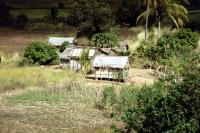 The morning I was leaving, I made a mistake. I have stayed in the hotel for breakfast. Apart from the lovely honey, of which the region is very well known (I haven't tasted a better sweet thing in my life), it was nothing special and it cost a weekly wage of an average Malagasy. For the amount I paid, I could have breakfasts for the entire month if I did them myself. I think they exaggerate over there. The service was also very slow and they were putting me behind the schedule again.
The morning I was leaving, I made a mistake. I have stayed in the hotel for breakfast. Apart from the lovely honey, of which the region is very well known (I haven't tasted a better sweet thing in my life), it was nothing special and it cost a weekly wage of an average Malagasy. For the amount I paid, I could have breakfasts for the entire month if I did them myself. I think they exaggerate over there. The service was also very slow and they were putting me behind the schedule again.
The way back from the park on the rough, mud road was a thrill again and it was taking ages. It was not raining this time round, so I could appreciate the scenery, take some photographs and the trip made an impression of taking a lot shorter.
The driver made me a ‘proposition’. he suggested that we continue to the Isalo National Park without stopping at Fianarantsoa. I originally wanted to stay at this university and cultural town, but I did not object. Of course I drove through the town and stopped to take a peek. There were few examples of fine architecture, but nothing really stroke me. On the hindsight, I should have spent there a bit more time and explored it properly.
The scenery around Fianarantsoa changes dramatically from primary rain forest to reasonably high mountains, which still with some tropical vegetation at the lower, wetter parts lose it completely around Ambalavao, south of Fianarantsoa, showing their bare rocks. One hill remarkably resembles the Australia's Ayer's Rock. It appears in the middle of the dry grass overgrown vast fields – savannah? It’s an exquisite view.
Malagasy people the farther south, got even friendlier, waving, smiling nicely and shouting ‘hello’, ‘vazaha’! And few species of baobabs appeared here and there. At least I thought they were baobabs. Surprisingly this area has not yet been announced a National Park, although in its vicinity there is one area-park under supervision of WWF.
Road between Fianarantsoa and Ihosy is new and in a very good condition, however narrow mostly, and particularly on bridges. The track after Ihosy loses the asphalt and the twice as slower journey on dark red sand begins. I guess one could call it a gravel road, but I am not entirely sure.
It is albeit a great fun as the base is hard the sand, or gravel, is a bit loose so one can still drive 50-60 km/h (31-37.3 mph) with a regular 2WD vehicle leaving the cloud of dust behind.
The landscape changes again into a very flat dry semi-desert plateau and all the clouds in the sky disappear leaving the sky very blue contrasting fantastically with the red dusty road and dry yellow-brown grass on the plateau. Unforgettable in every way! This is right up to the Isalo National Park, my next stop for couple of days.
|
Page:
 109 110 111 112 113 114 115 116
109 110 111 112 113 114 115 116

|
|
|
